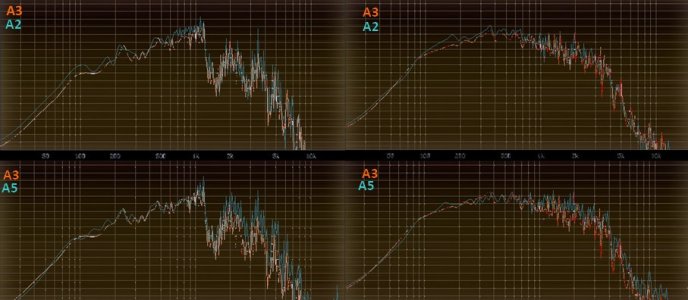Edit: I just reread all the comments. I think you all mean that the A3 is brighter than the A2. But how does it compare to the A5? (Which is what's in there now.)
At similar weight + dimensions and if magnetized in the same conditions, A5 is less inductive (since the A5 recipe basically contains less iron) and magnetically stronger.
Regarding the sound... I totally understand why our fellow members described the typical effect of A3 as they did but personally, I wouldn't define it as "brighter": it's more inductive and inductance promotes warmth... but it's also weaker and because of that, I has a kinda wider bandwidth. That's why I've evoked it as "flatter" - than A2, at least.
Wondering how I could help with something else than my clumsy words, I've searched in my archives and found a file (175 pages!) where various pickups are compared to each other with various magnets, in a same semi-hollow guitar.
The pics below involve a neck pickup of +/- 7.1k & 3.65H and therefore similar to a Jazz neck albeit with a lower Q factor, unpotted and wound with PE insulated wire.
It should still give an "idea" of what is going on.
Guitar was played direct to the board through the same cable capacitance in a 1M input.
Left column stacks single notes played from unfretted low E to 22th fret of high E. Until above 1khz, it's all fundamental notes. Beyond that, it's all harmonics.
Right column show chords on the six strings altogether, played from unfretted to 12th fret.
Orange lines translate what a RC A3 does. Blue lines translate the tonal shaping due to RC A2 (upper row) or to a short
and slightly degaussed RC A5 (bottom row).
Limitations of these pics: they tell nothing about dynamics, which is also different. I'll dig again in my archives in order to see if I've something to share about that.
FWIW. HTH.
 [I can' help to add that guitars, rigs and ears might react differently to magnets of a given alloy, depending on settings but also on the exact level of magnetization of each bar... While magnets of a "same" alloy from various eras / foundries might give rather different tones. Vintage A3's don't shape the tone in the same way than recent one, for example. Sorry for this tedious geeky parenthesis due to my anal side.
[I can' help to add that guitars, rigs and ears might react differently to magnets of a given alloy, depending on settings but also on the exact level of magnetization of each bar... While magnets of a "same" alloy from various eras / foundries might give rather different tones. Vintage A3's don't shape the tone in the same way than recent one, for example. Sorry for this tedious geeky parenthesis due to my anal side.  ]
]


